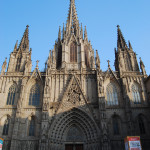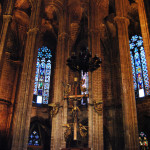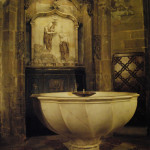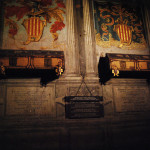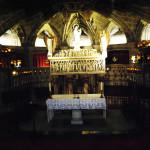Barcelona Cathedral
The Cathedral of Barcelona, which is officially called the Cathedral of the Holy Cross and Saint Eulalia is one of the most well-known landmarks of Barcelona and the chief religious institution of the city; it is also the seat of the Archbishop of Barcelona. Barcelona Cathedral is located at the very center of the Gothic Quarter, from which the history of Barcelona actually started.
The present building of the Cathedral, executed in the Gothic1 style, was built between the 12th and 15th centuries on the site of a Romanesque cathedral that had been built earlier, in the 11th century. A roman basilica of the 6th century which was dedicated to Saint Eulalia and was destroyed by the Moors in 985, served as the base for the cathedral’s construction.
(1Gothic Style is a style of art, beginning from the XIIth and until the XVIth century, which was the concluding stage in the development of the medieval art of the countries of Western, Central, and partially Eastern Europe. The term “Gothic” was brought into use in the Renaissance period as a derivative name for all medieval art that was perceived as “barbaric”).
At different times, the following architects participated in the cathedral’s construction: Jaime Fabre, Bertrand Ricker, and since 1397, Arnau Bargues. The construction was finished in the XVth century, but the main western façade was built only in 1889, and the spire – in 1913. The cathedral’s construction was finished according to medieval blueprints of the Cathedral in Rouen, so the cathedral in Barcelona combines the characteristics of the French and Spanish Gothic.
The interior of the temple is spacious, and it is characterized by the lack of light, so the cathedral is always immersed into twilight. The cathedral consists of three large naves; most of the central nave is occupied by a vast choir (1390). The choir’s railing includes marble reliefs by the famous Spanish sculptor of the XVIth century – Bartolomé Ordóñez. Over the railing, there are the famous wooden stalls decorated with antique heraldic coat of arms of the Catalan knights representing the Order of the Golden Fleece, which convened in the Cathedral in 1519, being called by Emperor Charles V and Archduke Maximilian of Austria.
The temple has 26 chapels. Left of the main entrance there is a Baptistery Chapel, the marble baptisteries in it were made by O. Julia in 1443. On the opposite side there is a Chapel of Lepanto (XVth century), where one of the temple’s relics is kept – the cross of the XVIth century, so called Christ of Lepanto (Sant Crist de Lepant). According to a local legend, during the Battle of Lepanto, this cross was on the board of the ship of Juan of Asturias.
The Chapel of Saint Benedict also stands out in the Cathedral. The Chapel is dedicated to the founder of the Benedictine Order and saint patron of Europe. The chancel screen Transfiguration was created by Bernat Martorell (1452).
On a special platform on the right hand of the main altar there is a painted wooden sarcophagus in which, according to the legend, Ramon Berenguer I, Count of Barcelona between 1035 and 1076, lies together with his wife Almodis de la Marche. However, it is not known whether the remains of the count and his wife are actually lying in the sarcophagus. It is also believed that during the construction of the Gothic cathedral, Ramon Borrell, Count of Barcelona; Alfonso the Liberal, Count of Barcelona and King of Aragon, and other members of the noble families were interred in its walls.
The chief relic of the cathedral is the tomb of Saint Eulalia, the patron of Barcelona. According to the legend, Saint Eulalia was a teenage girl who was martyred for the Christian faith in the IVth century. The Catalan tradition says that Eulalia was left naked on the central square of Barcelona to humiliate her and force her to submit, but in a miraculous way, right in the middle of spring, it snowed, and the snow covered her nakedness. Enraged Roman authorities put the girl to thirteen different tortures – one for each of the years of Eulalia’s life, and eventually crucified the young martyr on the cross. Thirteen white geese now live in the cloister2 of the present cathedral, because Eulalia was exactly thirteen years old, and, according to the legend, she was raising these birds in her little house in a small village Sarria.
(2Cloister (from Latin claustrum, an enclosed place, later — a monastery) — is a typical for Romanesque and Gothic architecture covered surrounding gallery, walling in an enclosed square courtyard, or an inner garden of a monastery, or of a large church. Usually the cloister is located along the wall of the building; one of its walls is blind, and the second one is an arcade or a colonnade. Quite often the open courtyard that is surrounded by the gallery is also called the cloister).
The sarcophagus with the remains of Saint Eulalia is in a crypt3 under the choir4. The sarcophagus is supported by eight columns. On all sides the sarcophagus is decorated with the scenes of Saint Eulalia’s martyrdom. The architect who built this sarcophagus was Lupo di Francesko, an architect from Pisa.
(3Crypt (from the Ancient Greek κρυπτή — a hidden underground vault or tunnel) — in medieval architecture of Western Europe it is one or several underground vaulted chambers, located under the chancel or choir of the temple and serving for burials and for exhibiting the saints’ and martyrs’ relics for worshipping. Another name for the crypt is a “lower” church).
(4Choir (Greek κλῆρος — a piece of land that has been acquired by a lot) — a place for singers on a platform on both sides in front of the altar.
The cathedral has two octagonal bell towers, erected at the end of the XIVth century. By elevator you can go up to the cathedral’s roof, from where one can see a beautiful view of the Gothic Quarter.

